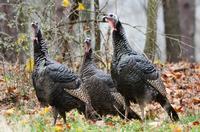The State We're In
Turkey Time
 If you live in rural or suburban New Jersey, chances are you’ve seen flocks of enormous dark birds foraging and hanging out in fields, backyards and along roadsides. And you’ve likely heard their telltale gobble or caught a glimpse of a male spreading its tail into a giant fan.
If you live in rural or suburban New Jersey, chances are you’ve seen flocks of enormous dark birds foraging and hanging out in fields, backyards and along roadsides. And you’ve likely heard their telltale gobble or caught a glimpse of a male spreading its tail into a giant fan.
They’re wild turkeys, and their numbers today are a result of a great conservation success story in this state we’re in! Over the course of our state’s history, they’ve been abundant, then absent, and are now back to being plentiful thanks to restoration efforts.
Wild turkeys weigh up to 20 pounds and stand a few feet tall, making them one of our largest and heaviest native birds.
Turkeys were plentiful across North America in colonial times, and are widely presumed to have been on the menu at the nation’s first Thanksgiving feast in 1621 in Plymouth, Massachusetts. Founding father Ben Franklin is rumored to have preferred them over the bald eagle for our national symbol, thinking them to be “a bird of courage” that would not hesitate to attack the British.
Wild turkeys were wiped out in New Jersey by the mid-1800s due to excessive hunting and loss of habitat. At the time, the Garden State had little remaining forests, most of it having been cleared for farming or chopped down for timber and firewood.
The Industrial Revolution brought good news for forests and turkeys when many rural New Jerseyans abandoned farm life for factory jobs in cities.
But wild turkeys couldn’t stage a comeback without human help. In 1977, the state Division of Fish & Wildlife, in cooperation with the New Jersey chapter of the National Wild Turkey Federation, released 22 birds captured in New York and Vermont near the Delaware Water Gap.
Within a couple of years, biologists began to live-trap and relocate turkeys around the state to establish new populations. By 1981, New Jersey’s turkey population had grown large enough to support a hunting season.
Wild turkeys are now abundant and stable throughout New Jersey. The Division of Fish & Wildlife estimates the population at 20,000 to 25,000 birds.
Anthony McBride, supervising biologist with the Division of Fish & Wildlife, said turkey numbers fluctuate from year to year. “Their populations will surge upwards when we have warm and dry springs, then decline when we have wet and cold springs,” he said.
“Right now, turkeys are in all available habitats in the state,” McBride added. “They’re everywhere they’re going to be.”
One reason for their success is their adaptable nature. They thrive with sizable oak forests, or patches of forest interspersed with farm fields or suburbs. They’re omnivores and will eat insects, acorns and nuts, salamanders, snails, mosses, plant buds, and underground plant bulbs.
They’re also prolific breeders. Males, or toms, are polygamous and often mate with several hens during the breeding season. Hens lay up to 17 eggs in shallow nests on the ground and may have multiple broods.
And Ben Franklin was right about their courage. Wild turkeys are not easily intimidated! In suburbia, flocks of turkeys have been known to wander onto decks and porches – and even to go through open doors and windows. Mail carriers and motorists have reported being surrounded by them.
McBride said his department is occasionally called upon to relocate turkeys if a suburban population gets too large and becomes an annoyance to neighbors.
Because of their size and prehistoric appearance, wild turkeys are hard to miss. From a distance, they appear black, but they’re really colorful with a beautiful bronze-green iridescence over their feathers. Their wing feathers have bold bars of black and white. They don’t migrate and can be seen in New Jersey all year round.
But you might hear them before you see them. The gobbling calls of males are loud, distinctive and carry long distances; females cluck quietly.
This Thanksgiving, give thanks for wild turkeys and the restoration efforts that brought them back to New Jersey!
To learn more about wild turkeys, visit the Cornell Lab of Ornithology website at www.allaboutbirds.org/guide/wild_turkey/id.
For more great sources of information about wild turkeys, go to www.state.nj.us/dep/fgw/turkey_info.htm or visit the National Wild Turkey Federation at http://www.nwtf.org/.
And for more information on preserving land and natural resources in New Jersey, click here or contact me at info@njconservation.org.
About the Authors
Alison Mitchell
Co-Executive Director
John S. Watson, Jr.
Co-Executive Director
Tom Gilbert
Co-Executive Director, 2022-2023
Michele S. Byers
Executive Director, 1999-2021
View their full bios here.
Filter
Get The Latest News
From The Garden State
In the
News
